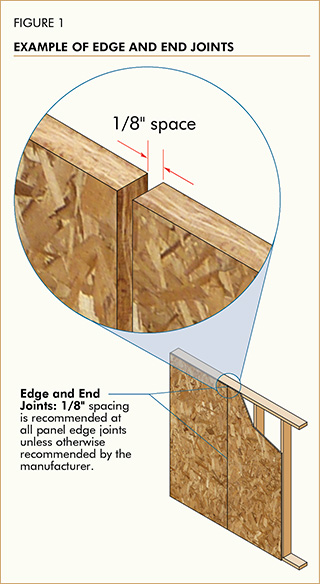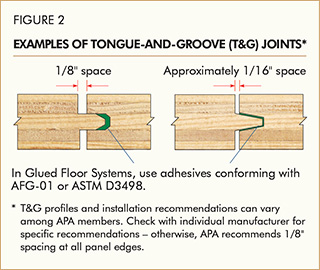Are you wondering if plywood needs an expansion gap? Well, you’ve come to the right place! Plywood is a versatile material used in various construction and woodworking projects. But when it comes to installation, there are certain considerations to keep in mind.
Now, you might be thinking, what exactly is an expansion gap? It’s a small space left between plywood panels to allow for natural expansion and contraction due to changes in temperature and humidity. This gap is important to prevent buckling, warping, or damage to the plywood.
But here’s the catch: not all plywood installations require an expansion gap. The need for an expansion gap depends on factors like the size of the plywood panels, the type of plywood used, and the environmental conditions where it will be installed. So let’s delve deeper into whether your plywood project needs that extra space or not.

Does Plywood Need an Expansion Gap?
In the world of construction and woodworking, plywood is a widely used material known for its strength, versatility, and affordability. Whether you’re building furniture, cabinets, or even entire structures, plywood is often the material of choice. However, when it comes to installing plywood, one question that often arises is whether or not it requires an expansion gap.
What is an Expansion Gap?
An expansion gap is a space left between two adjoining pieces of material to allow for any potential movement caused by changes in temperature, humidity, or moisture content. This gap provides room for the material to expand and contract without causing warping, buckling, or cracking. Expansion gaps are commonly used in various types of flooring installations, such as laminate, hardwood, and vinyl, to accommodate dimensional changes caused by temperature and moisture fluctuations.
When it comes to plywood, the need for an expansion gap is a topic of debate among professionals. Some argue that plywood, being a stable and dimensionally reliable material, doesn’t require an expansion gap. Others believe that an expansion gap is necessary to allow the plywood to adjust to environmental changes. To determine the correct approach, it’s essential to consider various factors, including the plywood’s intended use, the installation environment, and the specific type and quality of plywood being used.
Factors to Consider
1. Plywood Grade and Quality: The grade and quality of plywood can greatly influence whether or not an expansion gap is necessary. Higher-grade plywood, such as marine-grade or exterior-grade plywood, is typically more stable and less prone to warping or shrinking. These types of plywood may not require an expansion gap if installed in controlled environments with minimal temperature and humidity fluctuations.
2. Installation Environment: The environment in which the plywood is being installed plays a significant role in determining the need for an expansion gap. If the installation location experiences significant temperature and humidity variations, such as in outdoor applications or areas prone to moisture, it is generally recommended to leave an expansion gap. This allows the plywood to naturally adjust to the environment and reduce the risk of damage.
3. Intended Use: The purpose for which the plywood is being used can also impact whether an expansion gap is needed. For smaller, tightly fitted installations, such as cabinet or furniture making, an expansion gap may not be necessary. However, for large-scale installations like flooring or wall paneling, leaving an expansion gap is typically recommended to account for any potential expansion or contraction of the plywood over time.
Key Takeaways: Does Plywood Need Expansion Gap?
- Plywood generally requires an expansion gap to allow for natural wood movement.
- This gap prevents buckling, warping, and cracking of the plywood due to temperature and moisture changes.
- The recommended expansion gap for plywood is approximately 1/8 inch to 1/4 inch.
- The gap should be evenly distributed around the perimeter and between panels.
- Properly sealing the edges and treating the plywood can help minimize the effects of moisture and reduce the size of the expansion gap needed.
Frequently Asked Questions
When it comes to plywood installation, there are many factors to consider, including whether or not it needs an expansion gap. Here are some common questions people have about plywood and expansion gaps:
1. Why is an expansion gap necessary when using plywood?
An expansion gap is important when using plywood because wood is a natural material that expands and contracts with changes in temperature and humidity. Without an expansion gap, the plywood sheets may buckle or warp as they naturally expand. The gap allows the plywood to move without causing damage or compromising the integrity of the installation.
By providing a small space between the plywood sheets, it allows for natural expansion and contraction, preventing costly repairs or replacements down the line. Additionally, it helps to reduce the risk of moisture-related issues, such as rot or mold growth, by allowing proper airflow and ventilation.
2. How large should the expansion gap be for plywood?
The recommended size for an expansion gap when using plywood is typically about 1/8 inch or 3mm. It is important to note that the exact size may vary depending on factors like the type of plywood, the climate of the installation area, and the specific recommendations provided by the plywood manufacturer.
The purpose of the gap is to allow for natural movement, so it should be large enough to accommodate expansion and contraction without causing the plywood to buckle or warp. However, it should not be so large that it becomes noticeable or affects the overall aesthetic of the installation.
3. Do all types of plywood require an expansion gap?
While an expansion gap is generally recommended for plywood installation, not all types of plywood require one. Some plywood products, such as marine-grade plywood or specialty hardwood plywood, are designed to be more stable and less prone to expansion and contraction. In these cases, the need for an expansion gap may be minimal or not necessary at all.
It is always best to consult the manufacturer’s recommendations for the specific type of plywood you are using. They will provide guidance on whether or not an expansion gap is necessary and if any specific dimensions or spacing should be followed.
4. Can I use trim or molding to cover the expansion gap?
Using trim or molding to cover the expansion gap is a common practice in plywood installations. It can serve two purposes: providing a finished look and protecting the edges of the plywood from damage. However, it is important to ensure that the trim or molding is installed in a way that still allows for the necessary movement of the plywood.
The trim or molding should be attached in a way that it does not restrict the plywood’s natural expansion and contraction. It should be secured in a manner that allows for slight movement without causing the plywood to buckle or warp. It is recommended to leave a small gap between the trim and the plywood to accommodate this movement.
5. Are there any situations where an expansion gap should not be used?
While an expansion gap is generally recommended for plywood installation, there may be specific situations or applications where it is not necessary or not feasible to include one. For example, in certain structural or load-bearing applications where tight joints are required, an expansion gap may not be practical.
Additionally, in some cases where the plywood is being fully adhered or fully encapsulated within another material, such as in a subfloor or roof sheathing, the need for an expansion gap may be minimal or not necessary. It is important to follow industry guidelines and consult with professionals or experts in such cases to ensure proper installation without compromising structural integrity.

Summary
So, here’s what you need to know about whether plywood needs an expansion gap:
Plywood does not require an expansion gap like other materials because it is less prone to expansion and contraction. However, it’s essential to leave a small gap at the edges for the plywood to breathe and prevent buckling. Remember, always check the manufacturer’s instructions for specific recommendations.
In conclusion, while plywood doesn’t need a large expansion gap, giving it a little breathing room can help maintain its stability and prevent any potential issues down the road. So, make sure to leave a small gap around the edges when using plywood in your projects.
